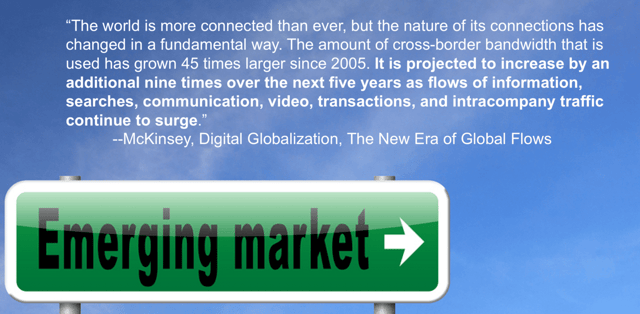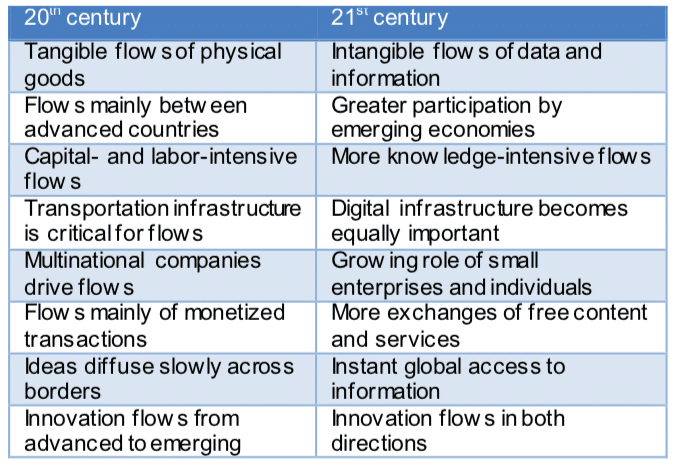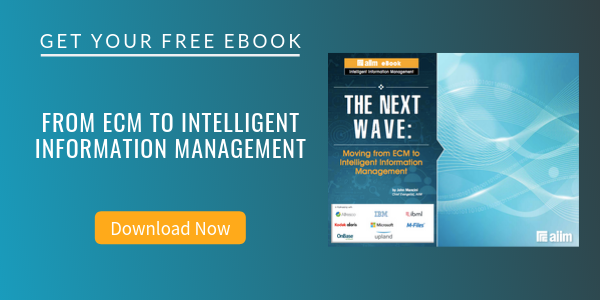
6 Things You Need to Know about Emerging Markets and Information Management
Enterprise Content Management (ECM) | Intelligent Information Management (IIM) | Digital Transformation
Digital disruption is moving quickly past the surface level of disruption as technology innovation in the consumer realm gets incorporated into the very fabric of how business is done, creating radical disruption along the way. All of this ultimately manifests itself in international trade, financial, and data flows and the impact these on the individual knowledge skills that workers need to have to survive and the organizational competencies in information management that companies and governments require to continue to be relevant and competitive.

I came across a great McKinsey study on this, Digital globalization: The new era of global flows, which got me thinking about the six points below.
1. The global trade, services, and financials flows that have traditionally driven the world’s economy have stalled.
We’ve been through the era in which trade flows were center stage. And we’ve been through the era in which financial flows assumed that role. The folks at McKinsey captured exactly the dynamic underway and the slowing in these flows since 2008.
- >Global trade in Goods is 10.5x larger now than in 1980 ($1.8 trillion vs. $19 trillion)
- Global trade in Services is 3.1x larger now than in 2002 ($1.6 trillion vs. $4.9 trillion)
- Global trade in Finance is 2.3x larger now than in 2002 ($0.7 trillion vs. $1.6 trillion)
2. We are now in an era in which global data and information flows are the primary determinant of economic benefit.
According to McKinsey, “The world is more connected than ever, but the nature of its connections has changed in a fundamental way. The amount of cross-border bandwidth that is used has grown 45 times larger since 2005. It is projected to increase by an additional nine times over the next five years as flows of information, searches, communication, video, transactions, and intracompany traffic continue to surge. In addition to transmitting valuable streams of information and ideas in their own right, data flows enable the movement of goods, services, finance, and people. Virtually every type of cross-border transaction now has a digital component.”
Digital disruption will be accelerated by the growing gaps between the world as it was and the world it is becoming.
3. This table from McKinsey puts a good edge on the transition that is underway:

4. Emerging markets are where much of the growth in information management will occur in the next decade.
Research predicts that emerging economies, which have for the first time contributed to more than half of the global trade flows, will account for over 45 percent of the Fortune Global 500 by 2025. This projection is nearly double the rate (26 percent) of 2013.
According to Gartner, emerging markets will be near $1.1 trillion in IT spending in 2016, which represents 31.3% of the worldwide IT spending in the same period. This is a considerable market share given severe market deceleration in some of the core traditional economies in the emerging category, particularly Brazil and Russia.
5. Radical disruption and its impact on emerging markets is opening up a host of opportunities for new players.
Like McQuivey, McKinsey notes that disruption opens up opportunities for a host of new players: “Globalization was once driven almost exclusively by governments, large multinational corporations, and major financial institutions. Today artisans, entrepreneurs, app developers, freelancers, small businesses, and even individuals can participate directly on digital platforms with global reach. Small and medium-sized enterprises (SMEs) worldwide are using the ‘plug-and-play’ infrastructure of Internet platforms to put themselves in front of an enormous global customer base and become exporters.”
This carries over into the content and information management landscape as well. Gartner’s Cool Vendor Report for emerging markets 2016 also highlights the opportunity that globalization and technology has provided emerging market players to compete globally. The report says that “what is interesting is that many local providers in these markets are increasing their investments in innovation and offering cutting-edge IT solutions to end users. While many of these solutions are native in their inception, they may well be successfully exported and adapted elsewhere in international markets, both mature and developing.”
6. In order to capitalize on the opportunities arising in emerging markets, organization must look hard at their organizational structures and the information systems that support them – and that means content management.
Per McKinsey, “The new era of digital globalization offers unprecedented opportunities for companies to achieve both global scale and efficiency, but it also calls for reevaluating existing strategies, business models, and operations. Business leaders in all industries should consider the following issues:
- Do your footprint and organizational structure make sense in a more digital world?
- Should you offer one brand and one product line around the world, or customize for local markets?
- Do you have the right suppliers and customer channels?
- Do you have the right assets to compete digitally and globally?
- Are you ready for a new era of digitally accelerated global competition?
- Are you prepared for new risks?”
Conclusion
Among both information management users and information management solution-providers, the digital disruption that is coming drives a number of opportunities and challenges.
On the user side, organizations must extend their content and information management capabilities into new markets, and understand how those markets are different from the traditional markets they serve, and think through how those different needs translate into different content management infrastructure requirements.
Similarly, content management solution providers have focused on established markets and economies. They will now face two pressures: 1) new “home-grown” content management competitors who really understand the unique issues of their home markets; and 2) pressures from their customer base to provide the tools they need to penetrate emerging market.
About John Mancini
John Mancini is the President of Content Results, LLC and the Past President of AIIM. He is a well-known author, speaker, and advisor on information management, digital transformation and intelligent automation. John is a frequent keynote speaker and author of more than 30 eBooks on a variety of topics. He can be found on Twitter, LinkedIn and Facebook as jmancini77. Recent keynote topics include: The Stairway to Digital Transformation Navigating Disruptive Waters — 4 Things You Need to Know to Build Your Digital Transformation Strategy Getting Ahead of the Digital Transformation Curve Viewing Information Management Through a New Lens Digital Disruption: 6 Strategies to Avoid Being “Blockbustered” Specialties: Keynote speaker and writer on AI, RPA, intelligent Information Management, Intelligent Automation and Digital Transformation. Consensus-building with Boards to create strategic focus, action, and accountability. Extensive public speaking and public relations work Conversant and experienced in major technology issues and trends. Expert on inbound and content marketing, particularly in an association environment and on the Hubspot platform. John is a Phi Beta Kappa graduate of the College of William and Mary, and holds an M.A. in Public Policy from the Woodrow Wilson School at Princeton University.



